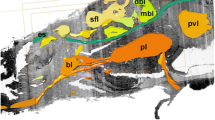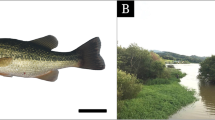Abstract
Formation and morphology of the olfactory organ of vertebrates has been intensely studied in some taxa for more than a century. As a functionally important and complex sensory organ, its ontogenetic development has often been a matter of debate on higher-level craniate evolution. However, sufficient knowledge of structure and development of the olfactory organ in the crucial taxa needed for a serious phylogenetic reasoning is generally not available. This study aims at this essential primary data source, the detailed structure, morphogenesis, and character definition of the olfactory organ in more basal clades of jawed vertebrates (Gnathostomata). Sturgeon fishes (Acipenseriformes) as recent basal actinopterygians are expected to provide insight into archaic characters and character combinations in bony fishes. Thus, the development of the olfactory placodes of the sterlet, Acipenser ruthenus, and the Siberian sturgeon, Acipenser baerii, was followed histologically, by semi-thin serial sections, and by scanning and transmission electron microscopy. Except for the timing, virtually no differences were observed between the two species. The olfactory placodes become two-layered early in embryonic development. Both the superficial epidermal and the subepidermal layer can easily be distinguished and their development followed by ultrastructural properties. There are three different types of receptor cells: ciliated, microvillous, and crypt cells. The development of the ciliated and the less abundant microvillous receptor cells from the subepidermal layer of the placode is demonstrated. The non-sensory cells of the differentiated olfactory epithelium, i.e. ciliated non-sensory cells and supporting cells, exclusively derive from the superficial epidermal layer. In this respect, acipenserids clearly demonstrate close resemblance to the morphogenetic process found in the tetrapod Xenopus (Anura). The only other adequately described mode found in the actinopterygian zebrafish (Danio rerio), is considered a derived character. In this case, all cells of the differentiated olfactory epithelium derive from one placodal cell layer. The mode of formation of the nasal sac and its ventilatory openings found in the acipenserids examined here, represents a widespread and probably a plesiomorphic condition of osteognathostomes. In both species, differentiation of the basic cellular composition of the olfactory epithelium is far advanced at the time of onset of extrinsic feeding.











Similar content being viewed by others
Abbreviations
- AF :
-
After fertilization
- AH :
-
After hatching
- LM :
-
Light microscopy
- SEM :
-
Scanning electron microscopy
- TEM :
-
Transmission electron microscopy
- ORN :
-
Olfactory receptor neuron
References
Baker CVH, Bronner-Fraser M (2001) Vertebrate cranial placodes. I. Embryonic induction. Dev Biol 232: 1–61
Ballard WW, Needham RG (1964) Normal embryonic stages of Polyodon spathula (Walbaum). J Morphol 114: 465–478
Balfour FM, Parker WN (1882) On the structure and development of Lepisosteus. Philos Trans Roy Soc, London 2: 359–442
Bartsch P (1993) Development of the snout of the Australian lungfish Neoceratodus forsteri (Krefft, 1870), with special reference to cranial nerves. Acta Zool Stockh 74: 15–29
Bartsch P, Britz R (1997) A single micropyle in the eggs of the most primitive living actinopterygian fish Polypterus. J Zool, London 241: 589–592
Bemis WE, Grande L (1992) Early development of the actinopterygian head. I. External development and staging of the paddlefish Polyodon spathula. J Morphol 213: 47–83
Berliner K (1902) Die Entwicklung des Geruchsorgans der Selachier. Arch Mikrosk Anat Entwicklungsmech 60: 386–406, pl. 20
Bertmar G (1965) The olfactory organ and upper lips in Dipnoi, an embryological study. Acta Zool Stockh 46: 1–40
Bertmar G (1969) The vertebrate nose, remarks on its structural and functional adaptation and evolution. Evolution 23: 131–152
Breucker H, Zeiske E, Melinkat R (1979) Development of the olfactory organ in the rainbow fish Nematocentris maccullochi (Atheriniformes, Melanotaeniidae). Cell Tissue Res 200: 53–68
Chen XY, Arratia G (1994) Olfactory organ of Acipenseriformes and comparison with other actinopterygians: Patterns of diversity. J Morphol 222: 241–267
Costanzo RM, Graziadei PPC (1987) Development and plasticity of the olfactory system. In: Finger TE, Silver WL (eds) Neurobiology of taste and smell. Wiley, New York, pp 233–250
Dean, B (1897) On the larval development of Amia calva. Zool. Jahrb Abt Syst 9: 639–672, pls. 9–11
Detlaff TA, Ginsburg AS, Schmalhausen OI (1993) Sturgeon fishes: developmental biology and aquaculture. Springer, Berlin Heidelberg New York
Devitsina GV, Kazhlayev AA (1993a) Chemoreceptor organs in early juvenile paddlefish, Polyodon spathula. J Ichthyol 33: 143–149
Devitsina GV, Kazhlayev AA (1993b) Development of chemosensory organs in Siberian sturgeon, Acipenser baeri, and stellate sturgeon, A. stellatus. J Ichthyol 33: 9–19
Dogiel A (1887) Ueber den Bau des Geruchsorgans bei Ganoiden, Knochenfischen und Amphibien. Arch Mikrosk Anat 29: 74–139
Eisthen HL (1992) Phylogeny of the vomeronasal system and of receptor cell types in the olfactory and vomeronasal epithelia of vertebrates. Microsc Res Technique 23: 1–21
Eisthen HL (1997) Evolution of vertebrate olfactory system. Brain Behav Evol 50: 222–233
Evans RE, Zielinski B, Hara TJ (1982) Development and regeneration of the olfactory organ in rainbow trout. In: Hara TJ (ed) Chemoreception in fishes. Elsevier, Amsterdam, pp 15–37
Gawrilenko A (1910) Die Entwicklung des Geruchsorgans bei Salmo salar. (Zur Stammesentwicklung des Jacobson'schen Organs). Anat Anz 36: 411–427
Hansen A, Zeiske E (1993) Development of the olfactory organ in the zebrafish, Brachydanio rerio. J Comp Neurol 333: 289–300
Hansen A, Zeiske E (1994) Cell proliferation in the olfactory organ of the embryonic and larval zebrafish, Brachydanio rerio. In: Kurihara K, Suzuki N, Ogawa H (eds) Olfaction and taste XI. Springer, Tokyo, p 755
Hansen A, Zeiske E (1995a) Development of the olfactory organ in zebrafish: an electron microscopic and immunocytochemical study of early differentiation and growth. Biofizika 40: 151–162 (Russian with English summary)
Hansen A Zeiske E (1995b) Development of the olfactory organ in zebrafish: an electron microscopic and immunocytochemical study of early differentiation and growth. Biophysics 40: 159–170
Hansen A, Zeiske E (1998) The peripheral olfactory organ in the zebrafish, Danio rerio: an ultrastructural study. Chem Senses 23: 39–48
Hansen A, Bartsch P, Kasumyan AO, Zeiske E (1999) A comparison of developmental processes in the olfactory organs of lower aquatic vertebrates. In: Elsner N, Eysel U (eds) Proceedings of the 27th Göttingen Neurobiology Conference 1999, vol 1. Thieme, Stuttgart, p 248
Hansen A, Nikonov, A, Anderson KT, Morita Y, Caprio J, Sorensen PW, Finger TE (2002) Olfactory receptor neurons: functional, structural, and molecular correlates. Soc Neurosci Abstr 847.12
Hansen A, Finger TE (2000) Phyletic distribution of crypt-type olfactory receptor neurons in fishes. Brain Behav Evol 55: 100–110
Hennig W (1966) Phylogenetic Systematics. University of Illinois Press, Urbana. Chicago, London
Hoffmann CK (1884) Zur Ontogenie der Knochenfische. Arch Mikrosk Anat 23: 45–108
Hofmann MH, Bleckmann H (1997) Subdivision of the olfactory system in the sterlet Acipenser ruthenus. Neurosci Lett 233: 154–156
Holm JF (1894) The development of the olfactory organ in the Teleostei. Morph Jahrb Gegenbaur 21: 620–624
Huesa G, Anadón R, Yánez J (2000) Olfactory projections in a chondrostean fish, Acipenser baeri: an experimental study. J Comp Neurol 428: 145–158
Kasumyan AO, Kazhlayev AA (1993) Formation of searching behavioral reaction and olfactory sensitivity of food chemical signals during ontogeny of sturgeons (Acipenseridae). J Ichthyol 33: 51–65
Kasumyan AO, Taufik LR (1994) Behavior reaction of juvenile sturgeons (Acipenseridae) to amino acids. J Ichthyol 34: 90–103
Kleerekoper H. (1969) Olfaction in fishes. Indiana University Press, Bloomington
Klein SL, Graziadei PPC (1983) The differentiation of the olfactory placode in Xenopus laevis: A light and electron microscope study. J Comp Neurol 217: 17–30
Kupffer C von (1893) Studien zur vergleichenden Entwicklungsgeschichte des Kopfes der Kranioten. 1. Heft. Die Entwicklung des Kopfes von Acipenser sturio an Medianschnitten untersucht. Lehmann, Munich
Kupffer C von (1894) Studien zur vergleichenden Entwicklungsgeschichte des Kopfes der Kranioten. 2. Heft. Die Entwicklung des Kopfes von Ammocoetes planeri. Lehmann, Munich
Menco BPM, Farbman AI (1985) Genesis of cilia and microvilli of rat nasal epithelia during pre-natal development. I. Olfactory epithelium, qualitative studies. J Cell Sci 78:283–310
Miyake T, Herbing IH von, Hall BK (1997) Neural ectoderm, neural crest, and placodes: Contribution of the otic placode to the ectodermal lining of the embryonic opercular cavity in Atlantic cod (Teleostei). J Morphol 231: 231–252
Morita Y, Finger TE (1996) Olfactory receptor cell morphology correlates with site of axon termination in the olfactory bulb. Soc Neurosci Abstr 22: 1072
Olsén KH (1993) Development of the olfactory organ of the Arctic charr, Salvelinus alpinus (L.) (Teleostei, Salmonidae). Can J Zool 71: 1973–1984
Pyatkina GA (1974a) Electron microscopic studies on the olfactory organ in sturgeons. Z Evol Biokhim Fiziol 10: 314–315 (in Russian with English summary)
Pyatkina GA (1974b) Electron microscopic investigation of the olfactory organ of the sturgeon Acipenser gueldenstaedti. In: Kreps EM (ed) Physiology and biochemistry of the lower vertebrates. Z Evol Biochim Fiziol (Suppl.). Nauka, Leningrad, pp 125–131 (in Russian with English summary)
Pyatkina GA (1975) Electron microscopic study of the olfactory organ in the sterlet Acipenser ruthenus. Arch Anat Gistol Embriol 68: 85–93 (in Russian with English summary)
Pyatkina GA (1976) Receptor cells of various types and their proportional interrelation in the olfactory organ of larvae and adults of acipenserid fishes. Tsitologiya 18: 1444–1449 (in Russian with English summary)
Reinke W (1937) Zur Ontogenie und Anatomie des Geruchsorgans der Knochenfische. Z Anat Entwicklungsgesch 106: 600–624
Reiss JO, Burd GD (1997) Cellular molecular interactions in the development of the Xenopus olfactory system. Semin Cell Dev Biol 8: 171–179
Salensky W (1881) Recherches sur le développement du sterlet (Acipenser ruthenus). Arch Biol 2: 223–341
Sorokin SP (1968) Reconstructions of centriole formation and ciliogenesis in mammalian lungs. J Cell Sci 3:207–230
Teichmann H (1964) Experimente zur Nasenentwicklung der Regenbogenforelle (Salmo irideus W. Gibb.) Wilhelm Roux Arch Entwicklungsmech Org 155: 129–143
Webb JF; Noden DM (1993) Ectodermal placodes: Contributions to the development of the vertebrate head. Am Zool 33: 434–447
Yamamoto M (1982) Comparative morphology of the peripheral olfactory organ in teleosts. In: Hara TJ (ed) Developments in aquaculture and fisheries science. Elsevier, Amsterdam, pp 39–59
Zeiske E, Kux J, Melinkat R (1976) Development of the olfactory organ of oviparous and viviparous cyprinodonts (Teleostei). Z zool Syst Evolut-forsch 14: 34–40
Zeiske E, Theisen B, Breucker H (1992) Structure, development, and evolutionary aspects of the peripheral olfactory system. In: Hara TJ (ed) Fish chemoreception. Chapman & Hall, London, pp 13–39
Zeiske E, Hansen A, Bartsch P, Kasumyan AO (1996) Development and growth of the olfactory organ of lower actinopterygian fish. Chem Senses 21: 692
Zeiske E, Hansen A, Bartsch P, Kasumyan AO (1997) Early development of the olfactory organ in lower actinopterygian fish: Acipenser (sturgeon) and Polypterus (bichir). Chem Senses 22: 833
Zielinski B, Hara TJ (1988) Morphological and physiological development of olfactory receptor cells in rainbow trout (Salmo gairdneri) embryos. J Comp Neurol 271: 300–311
Zielinski B, Hara TJ (1992) Ciliated and microvillar receptor cells degenerate and then differentiate in the olfactory epithelium of rainbow trout following olfactory nerve section. Microsc Res Technique 23: 22–27
Zippel HP, Hansen A, Caprio J (1997) Renewing olfactory receptor neurons in goldfish do not require contact with the olfactory bulb to develop normal chemical responsiveness. J Comp Physiol A 181: 425–437
Acknowledgements
The authors thank Dr. Bernd Schmeller and his staff (Störnstein, Germany) for providing sterlet eggs and ample help in raising the embryos and larvae. Thanks are also due to Brigitte Segner, Karin Meyer, Martina Wichmann, Renate Walter for their skillful assistance with TEM and SEM preparations.
Author information
Authors and Affiliations
Corresponding author
Rights and permissions
About this article
Cite this article
Zeiske, E., Kasumyan, A., Bartsch, P. et al. Early development of the olfactory organ in sturgeons of the genus Acipenser: a comparative and electron microscopic study. Anat Embryol 206, 357–372 (2003). https://doi.org/10.1007/s00429-003-0309-6
Accepted:
Published:
Issue Date:
DOI: https://doi.org/10.1007/s00429-003-0309-6




